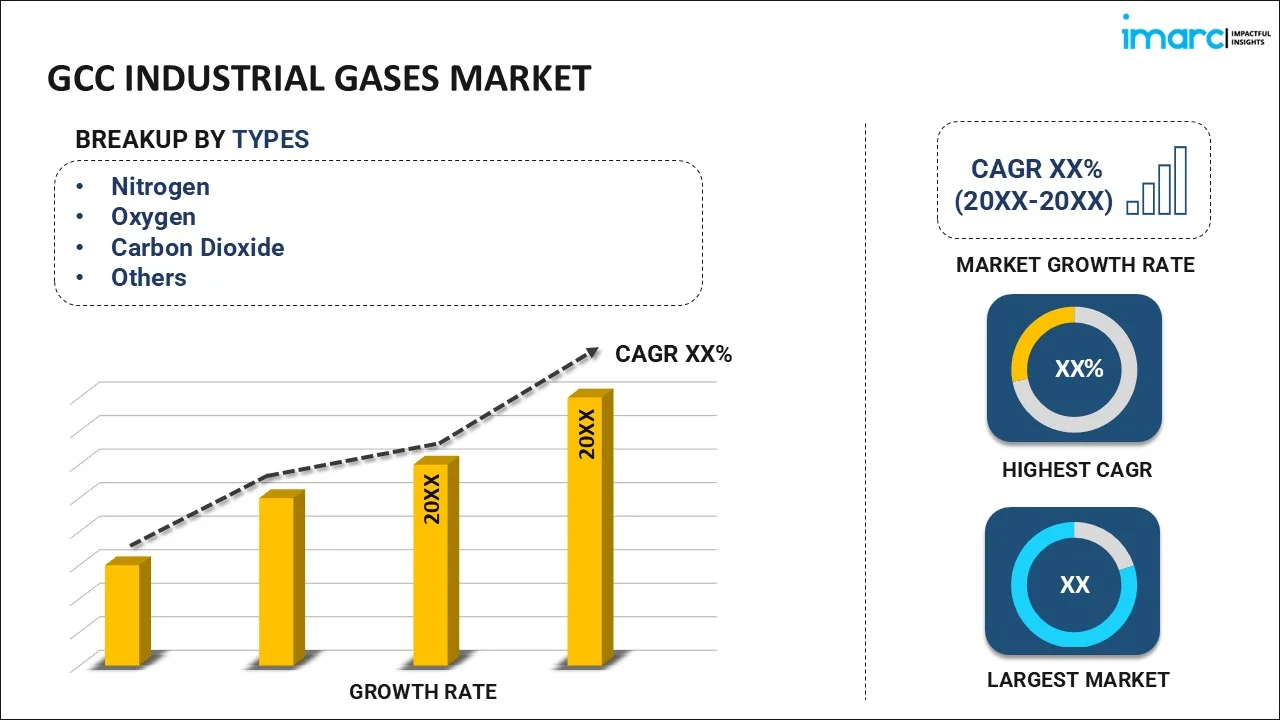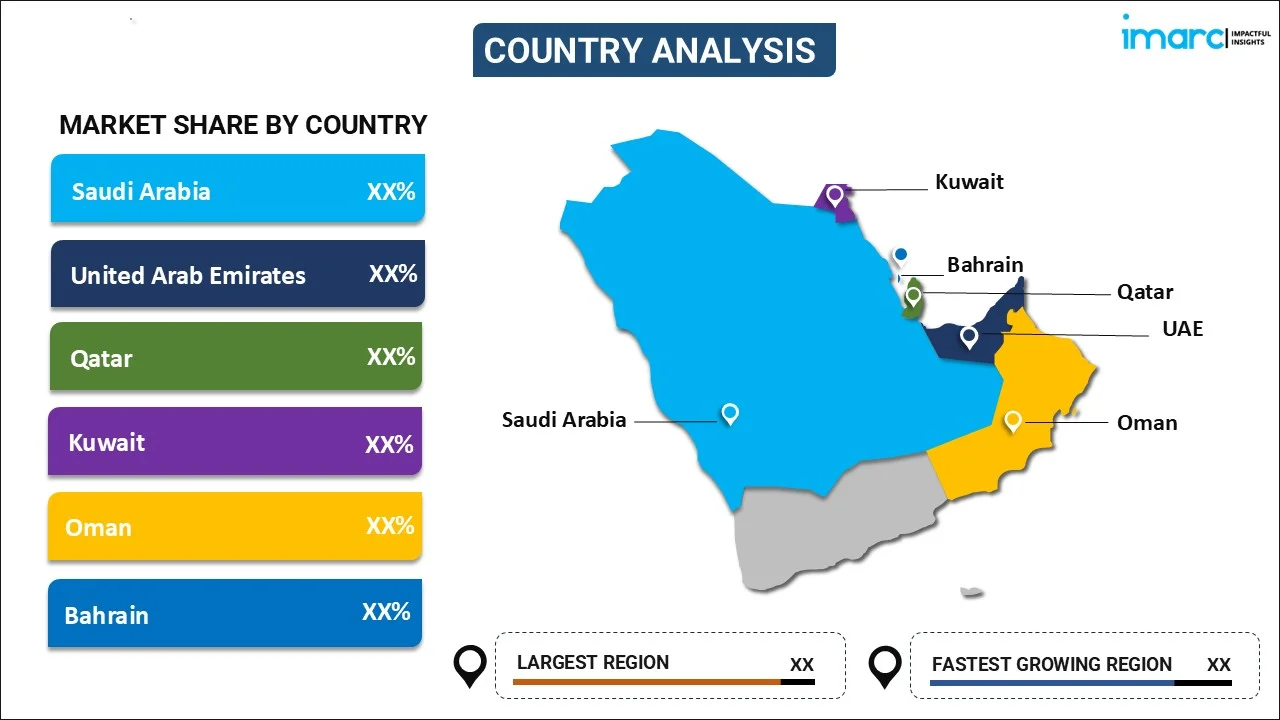
GCC Industrial Gases Market Report by Type (Nitrogen, Oxygen, Carbon Dioxide, Argon, Hydrogen, and Others), Application (Manufacturing, Metallurgy, Energy, Chemicals, Healthcare, and Others), Supply Mode (Packaged, Bulk, On-Site), and Country 2025-2033
Market Overview:
The GCC industrial gases market size reached USD 3.4 Billion in 2024. Looking forward, IMARC Group expects the market to reach USD 6.2 Billion by 2033, exhibiting a growth rate (CAGR) of 6.47% during 2025-2033.
|
Report Attribute
|
Key Statistics
|
|---|---|
|
Base Year
|
2024
|
|
Forecast Years
|
2025-2033
|
|
Historical Years
|
2019-2024
|
| Market Size in 2024 | USD 3.4 Billion |
| Market Forecast in 2033 | USD 6.2 Billion |
| Market Growth Rate 2025-2033 | 6.47% |
Industrial Gases are a group of organic compounds made up of different hydroxyl groups. Also known as sugar alcohols, industrial gases contain versatile carbohydrates with low calories and an identical taste and texture to table sugar. They are extensively utilized in the food and beverage industry as a sugar replacement in products like candies, chewing gums, ice creams, yogurts, and fruit spreads. Industrial Gases are also employed in toothpaste, mouthwash, throat lozenges, and breath mints. In the chemical industry, they have applicability in the production of flexible and rigid polyurethane coatings, foams, sealants, elastomers and adhesives.
The GCC represents one of the largest markets for industrial gases, primarily driven by product innovations. Polyol-based products have high durability, hardness and are light-weight, resistant to abrasion, and acts as insulating materials. Due to these properties, they are widely used in various sectors like electronics, footwear, packaging, and furniture. Besides this, the use of Industrial Gases-based foams in the automotive industry for the manufacturing of seating, headrest, armrest and ventilator headliners is also propelling the market growth. The market is further driven by the rising population and the growing demand for building materials, protective components, exterior panels, and housing electronics.
Key Market Segmentation:
IMARC Group provides an analysis of the key trends in each sub-segment of the GCC industrial gases market report, along with forecasts at the regional and country level from 2025-2033. Our report has categorized the market based on type, application and supply mode.
Breakup by Type:

- Nitrogen
- Oxygen
- Carbon Dioxide
- Argon
- Hydrogen
- Others
Breakup by Application:
- Manufacturing
- Metallurgy
- Energy
- Chemicals
- Healthcare
- Others
Breakup by Supply Mode:
- Packaged
- Bulk
- On-Site
Breakup by Country:

- Saudi Arabia
- UAE
- Qatar
- Oman
- Kuwait
- Bahrain
Competitive Landscape:
The competitive landscape of the industry has also been examined along with the profiles of the key players.
Report Coverage:
| Report Features | Details |
|---|---|
| Base Year of the Analysis | 2024 |
| Historical Period | 2019-2024 |
| Forecast Period | 2025-2033 |
| Units | Billion USD |
| Segment Coverage | Type, Application, Supply Mode, Country |
| Countries Covered | Saudi Arabia, UAE, Qatar, Oman, Kuwait, Bahrain |
| Customization Scope | 10% Free Customization |
| Post-Sale Analyst Support | 10-12 Weeks |
| Delivery Format | PDF and Excel through Email (We can also provide the editable version of the report in PPT/Word format on special request) |
Key Questions Answered in This Report
The GCC industrial gases market was valued at USD 3.4 Billion in 2024.
We expect the GCC industrial gases market to exhibit a CAGR of 6.47% during 2025-2033.
The rising utilization of industrial gases across the Food and Beverage (F&B) industry as a sugar replacement in various products, such as candies, chewing gums, ice creams, etc., is primarily driving the GCC industrial gases market.
The sudden outbreak of the COVID-19 pandemic had led to the implementation of stringent lockdown regulations across several GCC nations, resulting in the temporary halt in numerous production activities for industrial gases.
Based on the type, the GCC industrial gases market can be segmented into nitrogen, oxygen, carbon dioxide, argon, hydrogen, and others. Currently, nitrogen holds the majority of the total market share.
Based on the application, the GCC industrial gases market has been divided into manufacturing, metallurgy, energy, chemicals, healthcare, and others. Among these, manufacturing currently exhibits a clear dominance in the market.
Based on the supply mode, the GCC industrial gases market can be categorized into packaged, bulk, and on-site. Currently, packaged accounts for the largest market share.
On a regional level, the market has been classified into Saudi Arabia, UAE, Qatar, Oman, Kuwait, and Bahrain, where Saudi Arabia currently dominates the GCC industrial gases market.
Need more help?
- Speak to our experienced analysts for insights on the current market scenarios.
- Include additional segments and countries to customize the report as per your requirement.
- Gain an unparalleled competitive advantage in your domain by understanding how to utilize the report and positively impacting your operations and revenue.
- For further assistance, please connect with our analysts.
 Inquire Before Buying
Inquire Before Buying
 Speak to an Analyst
Speak to an Analyst
 Request Brochure
Request Brochure
 Request Customization
Request Customization




.webp)




.webp)












